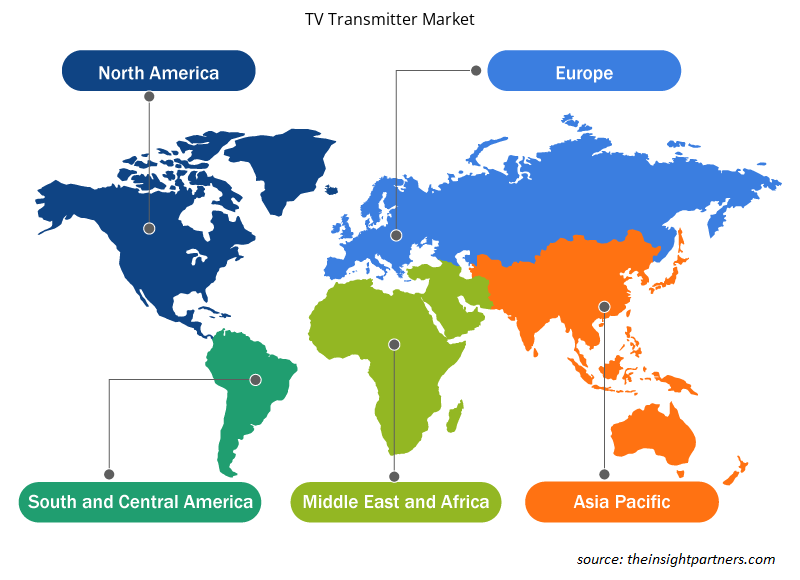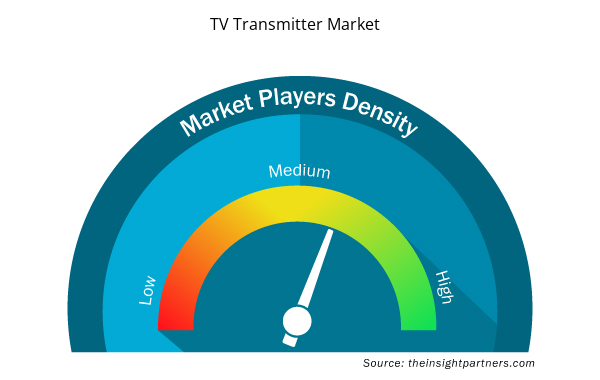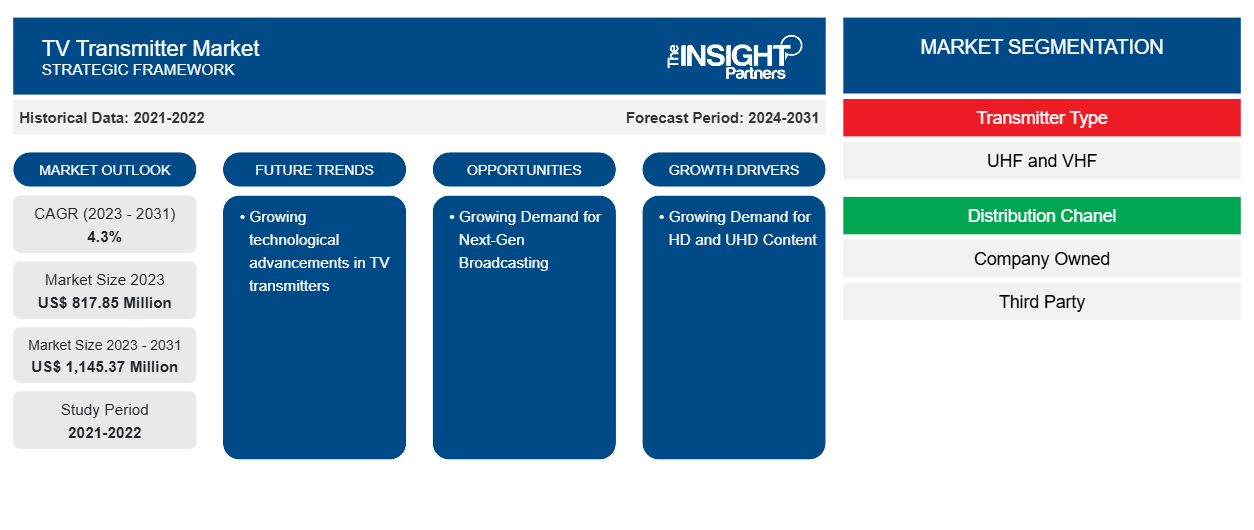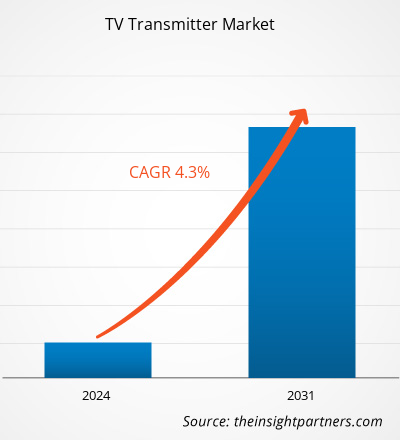Si prevede che la dimensione del mercato dei trasmettitori TV raggiungerà 1.145,37 milioni di $ USA entro il 2031 dagli 817,85 milioni di $ USA nel 2023. Si prevede che il mercato registrerà un CAGR del 4,3% nel 2023-2031. È probabile che la crescente domanda di contenuti ad alta definizione rimanga una tendenza chiave del mercato dei trasmettitori TV.
Analisi del mercato dei trasmettitori TV
La crescente domanda di contenuti HD e UHD in tutto il mondo è uno dei principali fattori che alimentano la crescita del mercato dei trasmettitori TV. Inoltre, le costanti innovazioni nel settore delle telecomunicazioni e della radiodiffusione stanno guidando la crescita del mercato dei trasmettitori TV. Inoltre, si prevede che la crescente domanda di trasmissioni di nuova generazione stimolerà la crescita del mercato nel periodo previsto . Inoltre, i crescenti progressi tecnologici nei trasmettitori TV stanno creando un'opportunità per la crescita del mercato dei trasmettitori TV nei prossimi anni.
Panoramica del mercato dei trasmettitori TV
Un trasmettitore TV è un dispositivo elettrico che emette onde radio che trasportano sia il segnale video che visualizza un'immagine dinamica sia il segnale audio che è sincronizzato con esso. Sarà ricevuto da un ricevitore televisivo, che visualizzerà l'immagine sullo schermo e riprodurrà il suono corrispondente. La sua frequenza operativa è limitata alle bande di frequenza VHF e UHF e la sua potenza di uscita varia da 5 W a 10 kW. È comunemente impiegato nel campo della trasmissione televisiva , come le stazioni TV.
Personalizza questo report in base alle tue esigenze
Riceverai la personalizzazione gratuita di qualsiasi report, comprese parti di questo report, o analisi a livello nazionale, pacchetto dati Excel, oltre a usufruire di grandi offerte e sconti per start-up e università
- Scopri le principali tendenze di mercato in questo rapporto.Questo campione GRATUITO includerà analisi di dati che spaziano dalle tendenze di mercato alle stime e alle previsioni.
Driver e opportunità del mercato dei trasmettitori TV
Crescente domanda di contenuti HD e UHD
La domanda di contenuti ad alta definizione ( HD ) e ultra-alta definizione ( UHD ) sta aumentando tra i consumatori in tutto il mondo, in particolare perché forniscono audio e video di qualità superiore. Inoltre, l'uso di piattaforme OTT sta aumentando in tutto il mondo insieme alle uscite di contenuti di alta qualità. Pertanto, la crescente domanda di contenuti di alta qualità sta alimentando la crescita del mercato dei trasmettitori TV.
CrescenteDomanda di trasmissione di nuova generazione
La trasmissione di nuova generazione include l'adozione di standard di trasmissione digitale, con diverse regioni in tutto il mondo che adottano standard specifici come ATSC 3.0 negli Stati Uniti, DVB-T2 in Europa e ISDB-Tb in alcune sezioni dell'Asia e del Sud America. I vantaggi di questi standard includono una migliore qualità audio e video, un uso più efficace dello spettro disponibile e l'aggiunta di nuove funzionalità interattive. La transizione agli standard di trasmissione digitale semplifica la trasmissione di programmi ad alta definizione ( HD ) e ultra-alta definizione ( UHD ), che offrono agli spettatori un'esperienza visiva e audio molto migliore e aumentano il loro godimento della televisione. Pertanto, si prevede che la crescente domanda di trasmissione di nuova generazione creerà un'opportunità per la crescita del mercato dei trasmettitori TV.
Analisi della segmentazione del rapporto di mercato dei trasmettitori TV
I segmenti chiave che hanno contribuito alla derivazione dell'analisi di mercato dei trasmettitori TV sono il tipo di trasmettitore, il canale di distribuzione e l'applicazione.
- In base al tipo di trasmettitore, il mercato dei trasmettitori TV è diviso in UHF e VHF. Il segmento UHF ha detenuto una quota di mercato maggiore nel 2023. Il segmento UHF è ulteriormente suddiviso in basso, medio e alto. Analogamente, il segmento VHF è ulteriormente suddiviso in basso e medio.
- Per canale di distribuzione, il mercato è segmentato in di proprietà aziendale e di terze parti. Il segmento di proprietà aziendale deteneva la quota maggiore del mercato nel 2023.
- Per applicazione, il mercato è segmentato in piccole emittenti televisive e grandi emittenti televisive. Il segmento delle grandi emittenti televisive deteneva la quota maggiore del mercato nel 2023.
Analisi della quota di mercato dei trasmettitori TV per area geografica
L'ambito geografico del rapporto sul mercato dei trasmettitori TV è suddiviso principalmente in cinque regioni: Nord America, Asia Pacifico, Europa, Medio Oriente e Africa e Sud America/Sud e Centro America.
In termini di fatturato, l'Asia Pacifica ha rappresentato la quota di mercato più grande dei trasmettitori TV. Il mercato in questa regione è segmentato in Australia, Cina, India, Corea del Sud, Giappone e il resto dell'APAC. Gli operatori di mercato nella regione lavorano costantemente sui progressi tecnologici nel settore della trasmissione, che è il fattore principale che alimenta la crescita del mercato dei trasmettitori TV nell'APAC. Inoltre, la regione sta assistendo a una crescita enorme nel suo settore dei media e dell'intrattenimento, che sta ulteriormente alimentando la crescita del mercato dei trasmettitori TV.
Approfondimenti regionali sul mercato dei trasmettitori TV
Le tendenze regionali e i fattori che influenzano il mercato dei trasmettitori TV durante il periodo di previsione sono stati ampiamente spiegati dagli analisti di Insight Partners. Questa sezione discute anche i segmenti e la geografia del mercato dei trasmettitori TV in Nord America, Europa, Asia Pacifico, Medio Oriente e Africa e Sud e Centro America.

- Ottieni i dati specifici regionali per il mercato dei trasmettitori TV
Ambito del rapporto sul mercato dei trasmettitori TV
| Attributo del report | Dettagli |
|---|---|
| Dimensioni del mercato nel 2023 | 817,85 milioni di dollari USA |
| Dimensioni del mercato entro il 2031 | 1.145,37 milioni di dollari USA |
| CAGR globale (2023-2031) | 4,3% |
| Dati storici | 2021-2022 |
| Periodo di previsione | 2024-2031 |
| Segmenti coperti | Per tipo di trasmettitore
|
| Regioni e Paesi coperti | America del Nord
|
| Leader di mercato e profili aziendali chiave |
|
Densità dei player del mercato dei trasmettitori TV: comprendere il suo impatto sulle dinamiche aziendali
Il mercato dei trasmettitori TV sta crescendo rapidamente, spinto dalla crescente domanda degli utenti finali dovuta a fattori quali l'evoluzione delle preferenze dei consumatori, i progressi tecnologici e una maggiore consapevolezza dei vantaggi del prodotto. Con l'aumento della domanda, le aziende stanno ampliando le loro offerte, innovando per soddisfare le esigenze dei consumatori e capitalizzando sulle tendenze emergenti, il che alimenta ulteriormente la crescita del mercato.
La densità degli operatori di mercato si riferisce alla distribuzione di aziende o società che operano in un particolare mercato o settore. Indica quanti concorrenti (operatori di mercato) sono presenti in un dato spazio di mercato in relazione alle sue dimensioni o al valore di mercato totale.
Le principali aziende che operano nel mercato dei trasmettitori TV sono:
- Rohde e Schwarz
- Società NEC
- Gruppo elettrico Hitachi Kokusai
- BTESA
- Egatel
- Cancelli Aria
Disclaimer : le aziende elencate sopra non sono classificate secondo un ordine particolare.

- Ottieni una panoramica dei principali attori del mercato dei trasmettitori TV
Notizie e sviluppi recenti sul mercato dei trasmettitori TV
Il mercato dei trasmettitori TV viene valutato raccogliendo dati qualitativi e quantitativi dopo la ricerca primaria e secondaria, che include importanti pubblicazioni aziendali, dati associativi e database. Di seguito è riportato un elenco degli sviluppi nel mercato dei disturbi del linguaggio e della parola e delle strategie:
- ENENSYS Technologies, fornitore leader di soluzioni di distribuzione multimediale, ed ELECTROLINK, produttore italiano di trasmettitori TV, hanno annunciato di aver consegnato con successo a Rai Way tutti i sistemi di trasmissione DVB-T/T2 operativi nelle regioni di Abruzzo, Lazio e Liguria, relativi al progetto di riqualificazione in Italia, affidato tramite gara pubblica. ENENSYS ed ELECTROLINK hanno creato una partnership speciale per questo progetto, ciascuna azienda fornisce i migliori componenti e servizi di ingegneria per fornire a Rai Way il sistema di trasmissione DVB-T/T2 più efficiente, affidabile e all'avanguardia. (Fonte: ENENSYS Technologies, comunicato stampa, 2023)
- Hope Channel Central Philippines ha inaugurato il nuovo studio e sito di trasmissione presso la sede centrale della Central Philippine Union Conference (CPUC) a Cebu City, Filippine. (Fonte: Avventisti, comunicato stampa, 2023)
Copertura e risultati del rapporto sul mercato dei trasmettitori TV
Il rapporto "Dimensioni e previsioni del mercato dei trasmettitori TV (2021-2031)" fornisce un'analisi dettagliata del mercato che copre le seguenti aree:
- Dimensioni e previsioni del mercato a livello globale, regionale e nazionale per tutti i segmenti di mercato chiave coperti dall'ambito
- Dinamiche di mercato come fattori trainanti, vincoli e opportunità chiave
- Principali tendenze future
- Analisi dettagliata delle cinque forze PEST/Porter e SWOT
- Analisi di mercato globale e regionale che copre le principali tendenze di mercato, i principali attori, le normative e gli sviluppi recenti del mercato
- Analisi del panorama industriale e della concorrenza che copre la concentrazione del mercato, l'analisi della mappa di calore, i principali attori e gli sviluppi recenti
- Profili aziendali dettagliati
- Analisi storica (2 anni), anno base, previsione (7 anni) con CAGR
- Analisi PEST e SWOT
- Valore/volume delle dimensioni del mercato - Globale, regionale, nazionale
- Industria e panorama competitivo
- Set di dati Excel



Report Coverage
Revenue forecast, Company Analysis, Industry landscape, Growth factors, and Trends

Segment Covered
This text is related
to segments covered.

Regional Scope
North America, Europe, Asia Pacific, Middle East & Africa, South & Central America

Country Scope
This text is related
to country scope.
Domande frequenti
The global TV transmitter market was estimated to be US$ 817.85 million in 2023 and is expected to grow at a CAGR of 4.3% during the forecast period 2023 - 2031.
Growing demand for HD and UHD content are the major factors that propel the global TV transmitter market.
Growing technological advancements in TV transmitters are anticipated to play a significant role in the global TV transmitter market in the coming years.
The key players holding majority shares in the global TV transmitter market are Rohde and Schwarz, NEC Corp, Hitachi Kokusai Electric Group, BTESA, Egatel, Gates Air, Toshiba, Gospell Digital Technology Co., Ltd., Plisch, and Syes.
The global TV transmitter market is expected to reach US$ 1,145.37 million by 2031.
Trends and growth analysis reports related to Electronics and Semiconductor : READ MORE..
The Insight Partners performs research in 4 major stages: Data Collection & Secondary Research, Primary Research, Data Analysis and Data Triangulation & Final Review.
- Data Collection and Secondary Research:
As a market research and consulting firm operating from a decade, we have published and advised several client across the globe. First step for any study will start with an assessment of currently available data and insights from existing reports. Further, historical and current market information is collected from Investor Presentations, Annual Reports, SEC Filings, etc., and other information related to company’s performance and market positioning are gathered from Paid Databases (Factiva, Hoovers, and Reuters) and various other publications available in public domain.
Several associations trade associates, technical forums, institutes, societies and organization are accessed to gain technical as well as market related insights through their publications such as research papers, blogs and press releases related to the studies are referred to get cues about the market. Further, white papers, journals, magazines, and other news articles published in last 3 years are scrutinized and analyzed to understand the current market trends.
- Primary Research:
The primarily interview analysis comprise of data obtained from industry participants interview and answers to survey questions gathered by in-house primary team.
For primary research, interviews are conducted with industry experts/CEOs/Marketing Managers/VPs/Subject Matter Experts from both demand and supply side to get a 360-degree view of the market. The primary team conducts several interviews based on the complexity of the markets to understand the various market trends and dynamics which makes research more credible and precise.
A typical research interview fulfils the following functions:
- Provides first-hand information on the market size, market trends, growth trends, competitive landscape, and outlook
- Validates and strengthens in-house secondary research findings
- Develops the analysis team’s expertise and market understanding
Primary research involves email interactions and telephone interviews for each market, category, segment, and sub-segment across geographies. The participants who typically take part in such a process include, but are not limited to:
- Industry participants: VPs, business development managers, market intelligence managers and national sales managers
- Outside experts: Valuation experts, research analysts and key opinion leaders specializing in the electronics and semiconductor industry.
Below is the breakup of our primary respondents by company, designation, and region:

Once we receive the confirmation from primary research sources or primary respondents, we finalize the base year market estimation and forecast the data as per the macroeconomic and microeconomic factors assessed during data collection.
- Data Analysis:
Once data is validated through both secondary as well as primary respondents, we finalize the market estimations by hypothesis formulation and factor analysis at regional and country level.
- Macro-Economic Factor Analysis:
We analyse macroeconomic indicators such the gross domestic product (GDP), increase in the demand for goods and services across industries, technological advancement, regional economic growth, governmental policies, the influence of COVID-19, PEST analysis, and other aspects. This analysis aids in setting benchmarks for various nations/regions and approximating market splits. Additionally, the general trend of the aforementioned components aid in determining the market's development possibilities.
- Country Level Data:
Various factors that are especially aligned to the country are taken into account to determine the market size for a certain area and country, including the presence of vendors, such as headquarters and offices, the country's GDP, demand patterns, and industry growth. To comprehend the market dynamics for the nation, a number of growth variables, inhibitors, application areas, and current market trends are researched. The aforementioned elements aid in determining the country's overall market's growth potential.
- Company Profile:
The “Table of Contents” is formulated by listing and analyzing more than 25 - 30 companies operating in the market ecosystem across geographies. However, we profile only 10 companies as a standard practice in our syndicate reports. These 10 companies comprise leading, emerging, and regional players. Nonetheless, our analysis is not restricted to the 10 listed companies, we also analyze other companies present in the market to develop a holistic view and understand the prevailing trends. The “Company Profiles” section in the report covers key facts, business description, products & services, financial information, SWOT analysis, and key developments. The financial information presented is extracted from the annual reports and official documents of the publicly listed companies. Upon collecting the information for the sections of respective companies, we verify them via various primary sources and then compile the data in respective company profiles. The company level information helps us in deriving the base number as well as in forecasting the market size.
- Developing Base Number:
Aggregation of sales statistics (2020-2022) and macro-economic factor, and other secondary and primary research insights are utilized to arrive at base number and related market shares for 2022. The data gaps are identified in this step and relevant market data is analyzed, collected from paid primary interviews or databases. On finalizing the base year market size, forecasts are developed on the basis of macro-economic, industry and market growth factors and company level analysis.
- Data Triangulation and Final Review:
The market findings and base year market size calculations are validated from supply as well as demand side. Demand side validations are based on macro-economic factor analysis and benchmarks for respective regions and countries. In case of supply side validations, revenues of major companies are estimated (in case not available) based on industry benchmark, approximate number of employees, product portfolio, and primary interviews revenues are gathered. Further revenue from target product/service segment is assessed to avoid overshooting of market statistics. In case of heavy deviations between supply and demand side values, all thes steps are repeated to achieve synchronization.
We follow an iterative model, wherein we share our research findings with Subject Matter Experts (SME’s) and Key Opinion Leaders (KOLs) until consensus view of the market is not formulated – this model negates any drastic deviation in the opinions of experts. Only validated and universally acceptable research findings are quoted in our reports.
We have important check points that we use to validate our research findings – which we call – data triangulation, where we validate the information, we generate from secondary sources with primary interviews and then we re-validate with our internal data bases and Subject matter experts. This comprehensive model enables us to deliver high quality, reliable data in shortest possible time.


 Ottieni un campione gratuito per questo repot
Ottieni un campione gratuito per questo repot